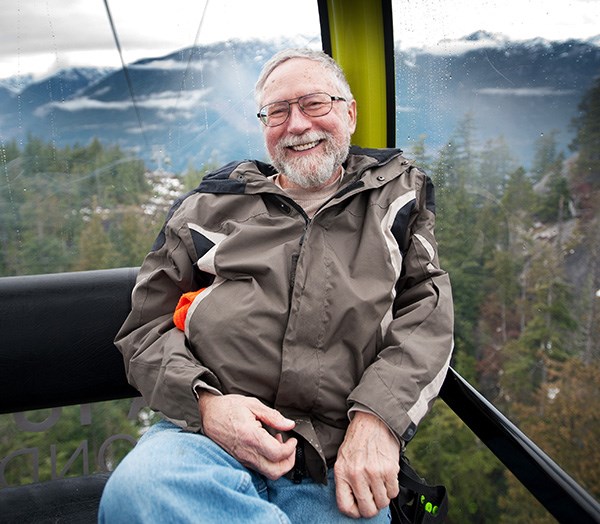Doug Brubacher could easily be called the king of the Sea to Sky Gondola.
Brubacher has made about 145 roundtrips – and counting – on the newly minted gondola during the eight months since it opened in May.
He has had his pass scanned at least 290 times (one time each way), more than anyone else who has visited the attraction, according to gondola staff. The 66-year old Garibaldi Highlands resident usually heads up as soon as the gondola opens at 10 a.m. with his wife, Sue, who has made about 125 roundtrips.
“It is a way we can go up into the mountains, and we love it,” Brubacher said.
“We aren’t the Spandex crowd, we can’t go out and do the mountain biking and kitesurfing and that kind of stuff… and this simply opened up a way for us to go up there.”
The couple, both now retired, moved to Squamish 13 years ago from southern Ontario, where Brubacher said there is nothing like the Sea to Sky Gondola.
“It is a new toy for us,” he said.
They originally came west for cleaner air and to fulfill a dream of living where they had often vacationed, Brubacher said.
The couple’s favourite thing to do is walk the 1.6 km long Panorama loop trail starting from the top of the gondola.
They walk the trail almost daily in the summer and most days so far this winter.
They were the first in line when the gondola reopened for winter in November, though Brubacher said they weren’t likely to try out the new snow-tubing park.
He said they have gone for dinner at the restaurant at the gondola’s summit more times than they have gone anywhere else in Squamish.
The couple likes taking the 10-minute ride up the 1,920-metre gondola so much, the company featured Brubacher and his family in a summer blog post on its website.
“I see them every day,” said Peggy Lai, 22, a lift operator who started working at the Sea to Sky Gondola in July. “They’re super nice.”
She said for Christmas the couple brought peanut brittle for the workers. Other times they have given cards to mark milestones in the lives of some employees, such as for graduations.
Brubacher agrees that he considers many of the approximately 80 full-time and 50 seasonal Sea to Sky Gondola employees friends.
“That is one of the things that keeps us going back, we go up for a nice walk and have a coffee, and every face we see is like seeing an old friend,” he said.
Brubacher, who was a heavy-duty equipment operator, also takes an interest in the mechanics of the gondola’s operation.
He said he has never been concerned about safety on the gondola, even though an empty cabin was damaged beyond repair when it crashed to the ground during testing before the attraction opened in May.
“I know there are some people who won’t try it,” Brubacher acknowledged, but he has no second thoughts about safety.
“This is a very common gondola style and I know the issue had a lot to do with wind,” he said. “You simply have to have faith that they have the issue fixed and when it is too windy… they shut down.”
The couple often takes their granddaughter, Kyra, up the gondola with them when she visits.
She has so far been up 55 times – and she is only three years old.
According to Brubacher, a unique aspect of the Sea to Sky Gondola is how it fits into its environment.
“One of the things that draws us to it is how incredibly well they have maintained a very unobtrusive footprint.
“You know, they have used the old gravel pit… and there is no stupid arcade up there – they have done it very tastefully,” he said.
He isn’t a fan of all gondolas; he said riding some is “like being stuffed into a Greyhound bus,” whereas the Squamish gondolas are “intimate little glass bubbles.”
It is very silent in the bubbles, especially at night, he said.
The Sea to Sky Gondola cars take a maximum of eight people.
Asked if he thinks he will ever tire of the gondola, Brubacher laughed and said no.
“There is something different to see. Just seeing the trees and the rocks and looking out over the water. All it takes is a different time of day for the lighting to be different and it becomes completely different,” he said.
“There are people who can go anywhere and don’t see a darn thing. We tend to see things. Our eyes are open. On days when you hike one of those trails and you are socked right in and so you can’t see anything. You look down and there is a whole world of likens and mosses, so you never run out of something new to see.”
He said he has seen bears and many kinds of birds including most recently a pair of ravens that seem to follow the couple as they walk.
For Brubacher, the project was well worth the $22-million that went into it and the approximate $90 cost of a season’s pass.
“It is definitely the best thing that has ever happened to Squamish,” he said.
“Squamish can be its own worst enemy when it comes to things that are good for it. Whether Squamish likes it or not, this put Squamish on the map and it is the best thing for it.
“It gives people a reason to stop here and then they look down and say, ‘Well, there is a town down there.’”




